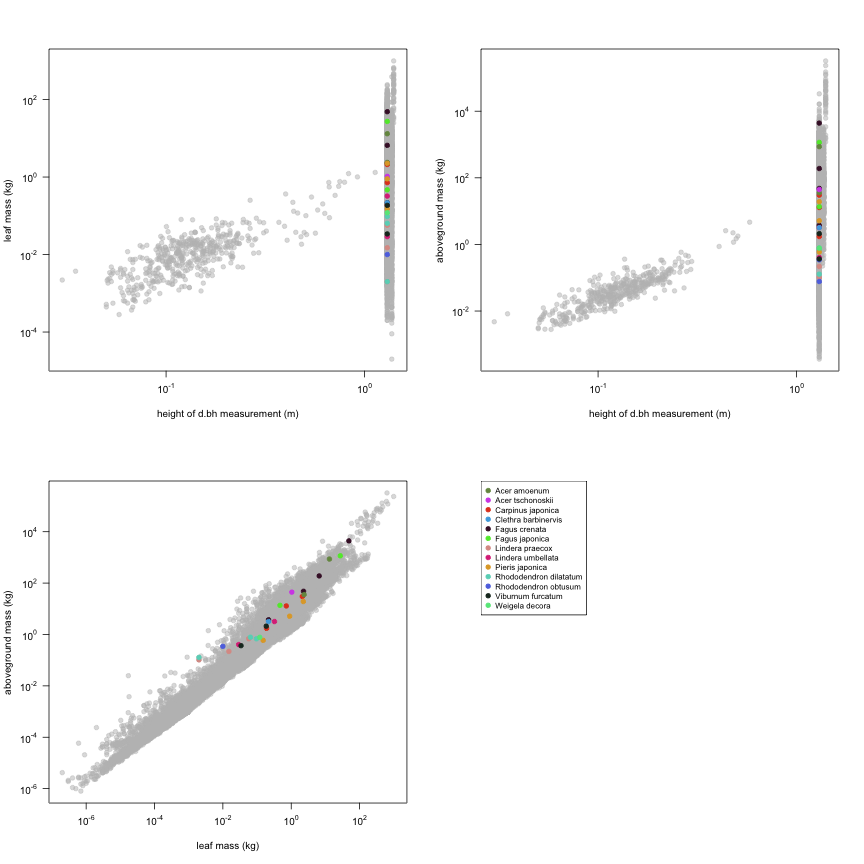-
Notifications
You must be signed in to change notification settings - Fork 19
Ikushima1964
Data contributor: Masae I. Ishihara, Hajime Utsugi, Hiroyuki Tanouchi, Tsutom Hiura
Email: masaish.n@gmail.com
Address:
- Graduate School for International Development and Cooperation, Hiroshima University, 1-5-1 Kagamiyama, Higashi-Hiroshima 739-8529, Japan
- Forestry and Forest Products Research Institute (FFPRI), 1 Matsunosato, Tsukuba, Ibaraki, 305-8687, Japan
- Hokkaido Research Center, Forestry and Forest Products Research Institute (FFPRI), Hitsujigaoka-7, Toyohira, Sapporo, Hokkaido, 062-8516, Japan
- Tomakomai Research Station, Field Science Center for Northern Biosphere, Hokkaido University, Takaoka, Tomakomai 053-0035, Japan
Citation: Ikushima T (1964). 'Productive structure of woody community.' Academic report of Tanzawa Oyama, Kanagawa Prefecture.
DOI:
Abstract:
The dataset includes records for 29 individuals from 13 species belonging to 7 family(ies), presenting 2 functional type(s), growing in 1 condition(s) within 1 major type(s) of habitat, with data included for the following variables:
| Variable | Label | Units | N | Min | Median | Max |
|---|---|---|---|---|---|---|
| latitude | Latitude | deg | 29 | 36 | 36 | 36 |
| longitude | Longitude | deg | 29 | 139 | 139 | 139 |
| a.lf | Leaf area | m2 | 28 | 0.012 | 1.8 | 449 |
| a.stbh | Stem area at breast height | m2 | 29 | 0.00002 | 0.0011 | 0.55 |
| d.bh | Dbh | m | 29 | 0.005 | 0.037 | 0.83 |
| h.bh | Height of d.bh measurement | m | 29 | 1.3 | 1.3 | 1.3 |
| m.lf | Leaf mass | kg | 28 | 0.002 | 0.22 | 49 |
| m.so | Aboveground mass | kg | 29 | 0.077 | 3.2 | 4399 |

And locally within the country:

The sites sampled are:
| Location | Longitude | Latitude | Vegetation |
|---|---|---|---|
| Japan-Tanzawa- | 139 | 35.5 | Temperate forest |
The growing conditions of sampled plants was:
| Location | growingCondition |
|---|---|
| Japan-Tanzawa- | field wild |
| Species | Family | Pft |
|---|---|---|
| Carpinus japonica | Betulaceae | deciduous angiosperm, evergreen angiosperm |
| Fagus crenata | Fagaceae | deciduous angiosperm, evergreen angiosperm |
| Fagus japonica | Fagaceae | deciduous angiosperm, evergreen angiosperm |
| Lindera umbellata | Lauraceae | deciduous angiosperm, evergreen angiosperm |
| Lindera praecox | Lauraceae | deciduous angiosperm, evergreen angiosperm |
| Acer amoenum | Aceraceae | deciduous angiosperm, evergreen angiosperm |
| Acer tschonoskii | Aceraceae | deciduous angiosperm, evergreen angiosperm |
| Clethra barbinervis | Clethraceae | deciduous angiosperm, evergreen angiosperm |
| Rhododendron dilatatum | Ericaceae | deciduous angiosperm, evergreen angiosperm |
| Rhododendron obtusum | Ericaceae | deciduous angiosperm, evergreen angiosperm |
| Pieris japonica | Ericaceae | deciduous angiosperm, evergreen angiosperm |
| Viburnum furcatum | Caprifoliaceae | deciduous angiosperm, evergreen angiosperm |
| Weigela decora | Caprifoliaceae | deciduous angiosperm, evergreen angiosperm |
Sampling strategy: Sample trees were selected in two locations (800-1200 m a.s.l.) to represent wide diameter ranges in August 1962 (Ikushima 1964). After trees were felled, diameter at breast height and tree height were measured.
Leaf area: Leaf area was estimated from subsamples (Ikushima 1964).
Height: Measured but not reported.
Biomass: Fresh mass of stem, branches, and leaves were measured. Measured fresh mass was converted to dry mass from the ratio of dry to fresh mass (Ikushima 1964). The ratio was estimated from subsamples taken for each tree. For several large-sized trees, fresh mass of stems were estimated from stem volume.
Other variables: M.I. Ishihara, H. Utsugi, H. Tanouchi, and T. Hiura conducted formal search of reference databases and digitized raw data from Ikushima (1964). Based on this reference, meta data was also created by M.I. Ishihara. Species name and family names were converted by M.I. Ishihara according to the following references: Satake Y, Hara H (1989a) Wild flower of Japan Woody plants I (in Japanese). Heibonsha, Tokyo; Satake Y, Hara H (1989b) Wild flower of Japan Woody plants II (in Japanese). Heibonsha, Tokyo.
This is how the study Ikushima1964 fits in the entire dataset (grey). each colour represents a species. A legend of species names with colours is included at the end for reports with 1 < n < 20 species.



